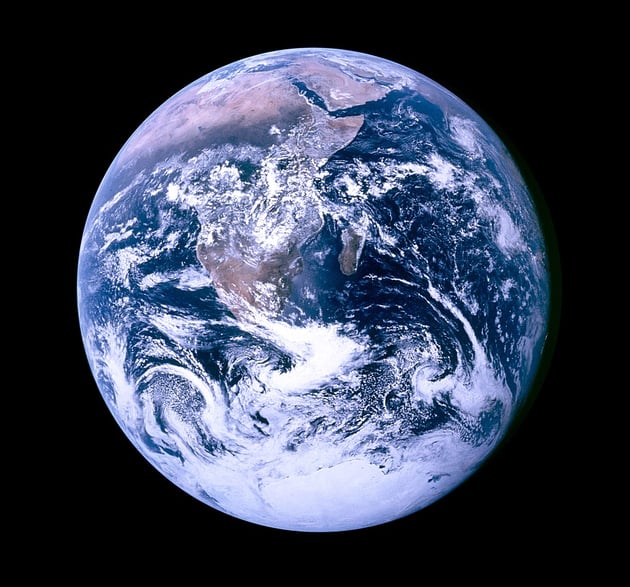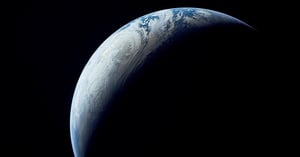“Astronomy compels the soul to look upwards” —Plato
For centuries, human beings have gazed up into the night sky contemplating what they observed. They saw patterns and images and named the constellations. From this activity they derived enough knowledge of the stars to use them for navigation, whether on land, in the desert, or on the water. They noticed certain stars which did not follow the pattern of the others and named them “wanderers.” They also knew the earth was not flat:
"How else would eclipses of the moon show segments shaped as we see them?[I]n eclipses the outline is always curved: and, since it is the interposition of the earth that makes the eclipse, the form of this line will be caused by the form of the earth’s surface, which is therefore spherical." —Aristotle, On the Heavens, 2.14
Looking down at earth

NASA. Photo taken by either Harrison Schmitt or Ron Evans (of the Apollo 17 crew)., Public domain, via Wikimedia Commons
In our time, the view has been reversed: a privileged set of human beings have been able to look down on the earth from the darkness of space. In his 1987 book, The Overview Effect, Frank White coined the term to name this unique human experience and its effect on astronauts. After conducting multiple interviews, he found that many had a distinct experience when seeing the earth from space, as described in this podcast from NASA:
The overview effect can create powerful shifts in the way you think about Earth and life. The words beautiful and fragile are often used by astronauts describing the experience….Part of it is seeing the Earth against the backdrop of the universe. You're actually seeing the universe for the first time in a way that no human has seen it.
Astronauts have described their experiences in quite poetic ways and often with deep emotion. Most of them admit to crying because the beauty of the earth is just heart-stopping.
”[When] looking down at the earth, you see the line that separates day and night slowly moving across the planet; thunder storms on the horizon casting these long shadows as the Sun sets; then watching the earth come alive with the lights from the cities and the towns.” —Ron Garan, Shuttle/ISS Astronaut
Flying over thunderstorms is described as watching a fireworks show complete with shooting stars and the “dancing curtains” of Auroras. Against the backdrop of numerous stars in the Milky Way, the Earth “really looks like a beautiful Oasis in the middle of nothingness, an Oasis against the backdrop of infinity.”
Astronauts, especially those in the International Space Station, spend a lot of their free time “earth gazing.” They can do this for hours because it is an ever-changing picture. It is during these times that they experience the “big picture effect,” a name used by astronauts prior to Frank White’s popularized expression, the “overview effect.”
The astronauts describe earth as looking more like a “living, breathing organism…and at the same time looks extremely fragile”. One of the more profound recognitions is that the endless blue sky, as seen from Earth, when viewed from space, is in reality a thin blue line “barely hugging the surface of the planet.”
"THE ONLY BORDER THAT MATTERS IS THAT THIN, BLUE LINE." —Nicole Stott, ISS Astronaut
Another powerful recognition shared by many astronauts is the recognition of the interconnectedness of the earth and of all people. For one astronaut, this happened while watching a dust storm in Africa traveling across the Atlantic Ocean to South America. For another, it was while watching a storm with “tentacles of light starting over Florida then moving out over the ocean as far as Africa…like watching neurons firing in the brain.” They describe a sense of belonging to the earth and the need to take care of it, just as it has taken care of its inhabitants.
In other words, their experience of seeing the earth from space changed how they view themselves and their place in the world and in the cosmos.
Although the overview effect is generated by this unique viewpoint, it shares many similarities with an experience available to earth-bound humans: awe.
The Science of Awe
Dr. David Bryce Yaden, assistant professor of Psychiatry and Behavioral Sciences at Johns Hopkins School of Medicine, has studied the experience of awe from a neuroscientific perspective. The most common sources of awe, he states, are nature, art, music, and witnessing or learning about the inspiring actions of others. Sometimes threatening experiences inspire awe as well, such as the power of a storm or natural disaster. He relates a conversation he had with his father-a firefighter-describing the terrifying beauty of a fire rolling across the ceiling!
Yaden’s definition of awe seems to fit well with the astronauts’ descriptions of the overview effect. He defines awe as “a perception of literal or figurative vastness” accompanied by the need for the mind to mentally process the experience because it is beyond one’s current frame of reference.
Interestingly, a remark made by Carl Sagan also captures this concept: "The size and age of the Cosmos are beyond ordinary human understanding. Lost somewhere between immensity and eternity is our tiny planetary home."
It is no wonder, then, that researchers have found that the descriptive elements of such an experience include: a loss of a sense of self, of time slowing down, feeling a sense of smallness, connectedness to all of humanity, and the presence of something greater than yourself.
It seems that Fred Hoyle was right when he commented in 1948:
Feature Image Credit: NASA, Public domain, via Wikimedia Commons"Once a photograph of the Earth, taken from outside is available…a new idea as powerful as any in history will be let loose."
